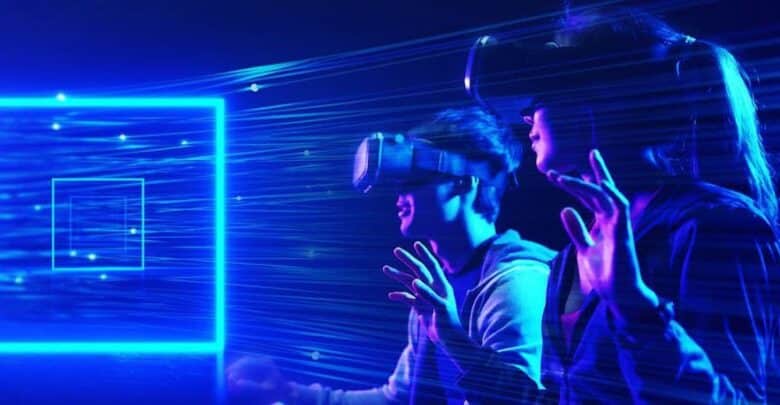
Both Facebook and Microsoft have showed their interest in the Metaverse in recent months, making it a popular subject of discussion. Is it possible to define the Metaverse? It’ll be here soon enough, but when?
The word “metaverse” was coined by author Neal Stephenson in his 1992 science fiction book “Snow Crash,” He imagined lifelike avatars meeting in 3D buildings and other virtual reality scenarios. It is only the beginning of a metaverse, an online virtual environment that includes 3D avatars, video, and other ways of communication. Numerous advances have set mileposts since then. As the Metaverse grows, your ability to live in a hyper-real alternate reality will increase.
These clues of the Metaverse may already be seen in popular online games such as Fortnite or Minecraft. They also have plans to be part of the Metaverse’s future development.
Brief Introduction to Metaverse
While the term “metaverse” may be traced back to Neal Stephenson’s 1992 dystopian, cyberpunk book Snow Crash, some believe it was inspired by Ernest Cline’s 2011 novel Ready Player One, which features a kaleidoscopic warren of experiences.
Chatrooms, AOL instant messaging, and the earliest social networking sites have been around since the mid-1980s when the internet was still in its infancy. Communities had sprung up in and around games since the early 2000s when World of Warcraft became a social phenomenon for millions of people. To younger generations, signing on to Fortnite, connecting with friends through the console, and starting a game with them is as social as most other physical interactions, particularly when it comes to gaming.
Metaverse (sometimes referred to as “web3” by some) is fundamentally a progression of the internet as we know it today. The Metaverse promises that our digital and physical lives will become more intertwined in wealth, sociability, productivity, and commerce, even if it’s only on a screen. It doesn’t need a headset to see how these two worlds are already connected. Consider how far the Uber app can inform you about the car’s position by using your phone’s GPS. Think of Netflix as an analogy to create recommendations based on your previous viewing history. Newer iPhones include a LiDAR sensor that can take a 3D image of your environment.
Banks and investors are paying attention. According to John Egan, CEO of L’Atelier BNP Paribas and an investment analyst specializing in new technology, “there’s certainly a type of desire to travel that route. As a result of this metaverse principle, we can build whatever world we envision.
Why Is It So Unnatural?
According to experts, the term Metaverse was created in a science fiction novel many years ago. For the rest of us, though, it seems like something Mark Zuckerberg concocted to gather as much information as possible about us so he can sell it to advertisers. To make things more frightening, they’ll almost certainly invent new kinds of false news and conspiracy theories.
Conspiracy theories abound concerning the usefulness of this feature, mainly since Facebook was the first to promote it.
Let me reassure you that this is a natural occurrence. And it might have a significant impact on our lives.
As a starting point, I’d want to point out that there isn’t just one “Metaverse.” It is expected that the number of “Metaverses” will rise shortly. These will include those used for business, trade, education, and entertainment. Please focus on the commercial applications first, but I’m sure that others will follow.
Assumptions for the Metaverse Business
Before I go any further, I’d want to point out that the Metaverse is today’s internet. A lot of new stuff is on the way. Remember that the first web was text-based, sluggish, and didn’t even have video.
There has already been some development in the Business Metaverse. We aim to go from “e-learning” to “we-learning” to “digital learning” and eventually “immersive learning” in our training. From onboarding and training to leadership development and meetings, this opens up a slew of new opportunities for large-scale staff gatherings and entertainment.
During a recent meeting with Microsoft product teams, I was impressed by their intentions. Mesh for Teams, which is expected to be released in mid-2015, will allow you to replace your video presence with an avatar, construct virtual rooms, and introduce 3D places inside Teams. You may create a 3D trade display, educational conference, or new employee orientation using Teams. I’m sure there will be a massive wave of interest in this technology in the following months and years.
Assuming other companies implement this, I can see Microsoft Metaverse providing virtual tours of the facilities where your items are made. Your customers may participate in real-life scenarios with your sales staff. Your company’s training scenarios may now be simulated in 3D using a platform like STRIVR, which experts in the industry have designed. For a fraction of the cost of real-world simulations, you may already use STRIVR experiences in various ways.
STRIVR developed a Metaverse software for a utility business that taught its employees how to walk down into a maintenance hole, find the instruments and safety valves that need to be adjusted, and fix or diagnose issues without posing a danger. Without virtual reality, this form of instruction would be prohibitively costly, risky, and heavily rationed. STRIVR (a Metaverse application) makes this possible at a large scale.
Accenture has made a significant bet in this arena. Microsoft has created an entire team of AR consultants to assist large corporations in developing Metaverse-powered applications. The likes of Zoom, Webex (Cisco), Nvidia, Netflix, and Apple are all likely participants.
Metaverse and the World of Gaming are Two Different Things
Maximo believes that the Metaverse’s infrastructure and games are two of the most crucial components for investors. In light of this, Maximo noted that “we look at two parts of the puzzle: the games that have blockchain connectivity via NFTs and tokens, and the protocols that give infrastructure for game creators to construct blockchain-compatible games.”
“Decentraland,” for example, is a cryptocurrency that exists inside the crypto sphere,” he said. The MANA token, issued by Decentraland, allows users to create, experience, and market virtual reality content and applications by using the Ethereum network. Individuals may develop, tinker, and monetize their plots of land in the virtual world by buying land in the virtual world.
There are massive commercial platforms (like Facebook) that connect, exchange information, and play games with one other, as stated in the Decentraland whitepaper. Network effects have helped online groups and gaming firms grow in popularity. As well as keeping an eye on network policies and content, this kind of organization generates a significant amount of revenue from the groups and content producers who increase traffic to its networks. The objective of Decentraland is to “Decentraland wants to build a network where content creators can own and profit fully from the work they produce.”
A Multi-Billion-Dollar Investment
Coingecko estimates that MANA, which has a market valuation of $5.5 billion, has increased by 249.2 percent in the previous month. MANA is a cryptocurrency. The Metaverse is worth a total of $35.7 billion in terms of market capitalization.
MANA access in the form of security may now be obtained via Grayscale’s Decentraland Trust, which eliminates all the hassles associated with buying, storing, and securing MANA on the open market.
According to Maximo, it’s an intriguing notion to have tokens that you may win by participating in the game.
This trend is catching players in underdeveloped nations like the Philippines and Venezuela who want to own the worth of their in-game time, he said. Many gamers earn more money playing these games than they could ever make working in a traditional job or even in government, according to some estimates.
It’s vital to highlight that the altering income structures of game creators are the primary driver of this upward trend. A large number of industry insiders agree with our assessment of the current state of affairs.
It is estimated that the Axie coin (AXS) has a market valuation of $8.88 billion, according to Coingecko. There has been a 31.21 percent growth in the past year.
UFO Gaming, according to Cymbalisty, is a newer endeavor that merits more study. “The finest of Axie and Decentraland into one enormous metaverse,” as stated on the website.
Although Decentraland and Axie are “maybe regarded independent galaxies,” Mr. Axie said that UFO “aims to be the metaverse cosmos,” as he put it.
UFO’s current market value is $1.5 billion, up 148% from 30 days ago, according to Coingecko’s calculations.
What Qualities Are Most Important to Investors?
Grayscale’s Maximo says it’s “difficult to tell” which indicators investors should be looking at for metaverse-linked currencies since most crypto coins in the gaming sector aren’t in the top 100.
In the early phases of the industry, he said that market size, transaction count, and protocol revenue are important metrics to keep an eye on. The future of infrastructure or a specific game must also be taken into consideration by investors.
The number of transactions and money generated by the protocol tells us how often and how many people participate in the game. According to Maximo, a cryptocurrency token’s future orientation may be predicted using market capitalization and trading volume.
To build a community, Decentraland conducts Creator Contests that encourage community members to create Decentraland-related content, he says. He said this might be best understood by examining the game’s performance in online social media, particularly YouTube and Twitter. You may attract new players by posting gameplay videos and broadcasting them live.
Holograms and Metaverse
When the internet was initially introduced, a succession of technical advances was made possible, such as communicating with computers over vast distances or creating hyperlinks connecting different web pages. These technological capabilities served as the foundation for everything we now associate with the internet: websites, applications, social networks, and everything else that is built on top of those foundational components. The convergence of non-internet interface improvements, such as displays, keyboards, mice, and touchscreens, are all essential to make the internet function.
It is possible to host hundreds of individuals on a single server instance with a metaverse, and future versions should be capable of handling thousands or even millions of people simultaneously. Motion-tracking technologies are also possible, telling where a person is looking and where their hands are. These cutting-edge innovations have the potential to excite people and give them a sense of the distant future.
It’s conceivable that the obstacles you’re up against are too significant for you to overcome. Companies like Microsoft and Fa—Meta, while showcasing their future ideas via fictitious movies, typically overlook the specifics of how users will interact with the Metaverse in the real world. For the time being, virtual reality headsets are cumbersome and uncomfortable to use for extended periods. In addition to finding out how individuals can use them in public without seeming like enormous dorks, augmented reality glasses have a similar difficulty
A three-dimensional image appearing in midair under precisely regulated conditions isn’t as janky as motion-tracked digital avatars, which are now imperfect but might be improved in the future.
This type of obfuscation of reality is common in metaverse-related video demonstrations. Is this individual seated at a desk or attached to an immersive aerial gear in another of Meta’s demos? Is there a headset on the hologram’s head, and if so, how is their face being scanned as they speak? Additionally, a user may be seen grabbing virtual things and holding them in what seems to be their real hands at several moments during the game.
These crazy demonstrations by Microsoft, Meta, and many other firms aim to evoke the future creatively, not to answer every technological concern. We can thank AT&T for this long-standing habit, which dates back to a demonstration of a voice-controlled foldable phone that could magically remove people from photographs and produce 3D models.
It’s challenging to know which portions of the many metaverse ideas will come to fruition due to this type of wishful thinking masquerading as a tech presentation. There is a chance that a virtual poker game in which your opponents are robots and holograms floating in space may become a reality if VR and AR headsets become comfortable and affordable enough for people to wear them every day. If not, you could always use a video conference on Discord to play Tabletop Simulator.
Virtual and augmented reality’s flashiness also obscures the Metaverse’s more commonplace components, which may be more likely to come to fruition. For example, computer firms might easily create an open digital avatar standard that includes features like eye color, haircut, and outfit choices and allow you to take it with you everywhere you go. Virtual reality headsets don’t need to be comfier for that. However, imagining that isn’t nearly as much fun.
What’s the Current State of the Metaverse?
It’s impossible to describe the Metaverse without taking away the present, which creates an interesting dilemma. Our virtual worlds already include:
- MMOs (massively multiplayer online games)
- Virtual concerts
- Video conversations with people from all over the globe
- Virtual characters
A fresh picture of the world can only be sold when there is something new in it.
It’s just as essential to the metaverse concept as any other form of hype. As a result, it should be no surprise that those who are supporting NFTs – cryptographic tokens that may act as digital certificates of ownership, like that used in the real world — are also enthusiastic about the Metaverse. Assuming that NFTs can be claimed to be the digital key to your virtual house in Roblox, then that’s a big deal. A simple pastime of purchasing memes has become a vital part of the internet’s future (and may even increase the value of your cryptocurrencies).
Even if it’s easy to draw parallels between the early internet and the proto-metaverse notions we have now and think that things will get better and grow linearly, it’s not guaranteed that this will be the case. A virtual office or poker game with Dreamworks CEO Mark Zuckerberg isn’t a sure thing, much less if virtual reality and augmented reality will ever become as commonplace as smartphones and computers are now.
For all we know, we could simply be looking at VR games and digital avatars in Zoom conversations rather than a whole new “metaverse” if it ever existed.
Buying land in The Sandbox or Decentraland, for example, is another option to invest in these Metaverse games’ NFTs. Platforms like OpenSea allow you to purchase these NFTs in two ways: via auction or a buy it now option. But there is a drawback: many of these NFTs have exorbitant beginning pricing. On OpenSea, for example, the lowest-priced land for The Sandbox is offered at USD 3500.
Meta (FB), Roblox (RBLX), and Matterport (MTTR) are all strongly associated with the Metaverse, and each firm has its distinct potential. In addition to owning VR equipment maker Oculus, Meta, better known as Facebook, is a social networking platform. Matterport, on the other hand, is a firm that uses cameras and software to build virtual spaces by digitizing the real world.
Tokenhell produces content exposure for over 5,000 crypto companies and you can be one of them too! Contact at info@tokenhell.com if you have any questions. Cryptocurrencies are highly volatile, conduct your own research before making any investment decisions. Some of the posts on this website are guest posts or paid posts that are not written by Tokenhell authors (namely Crypto Cable , Sponsored Articles and Press Release content) and the views expressed in these types of posts do not reflect the views of this website. Tokenhell is not responsible for the content, accuracy, quality, advertising, products or any other content or banners (ad space) posted on the site. Read full terms and conditions / disclaimer.







